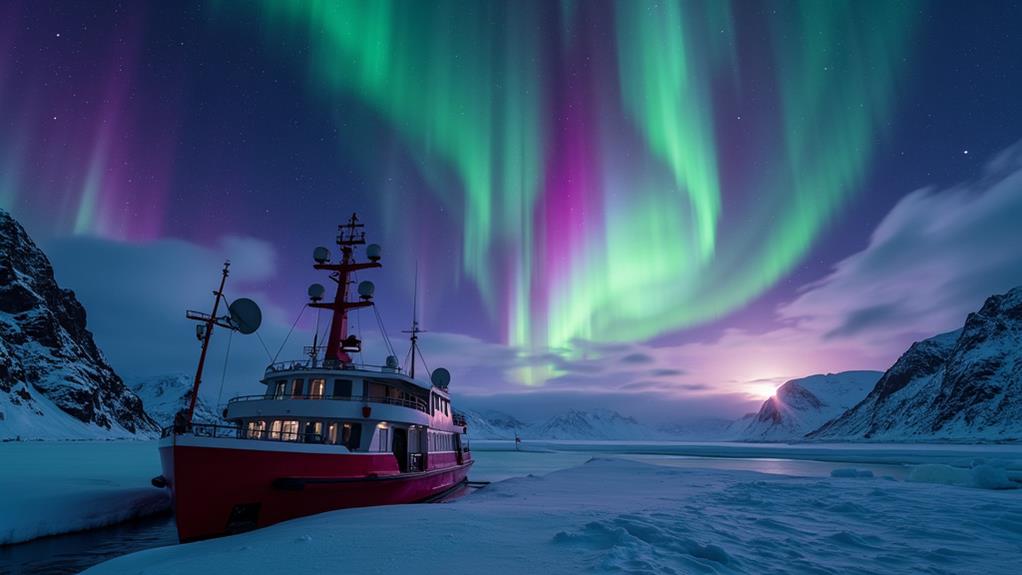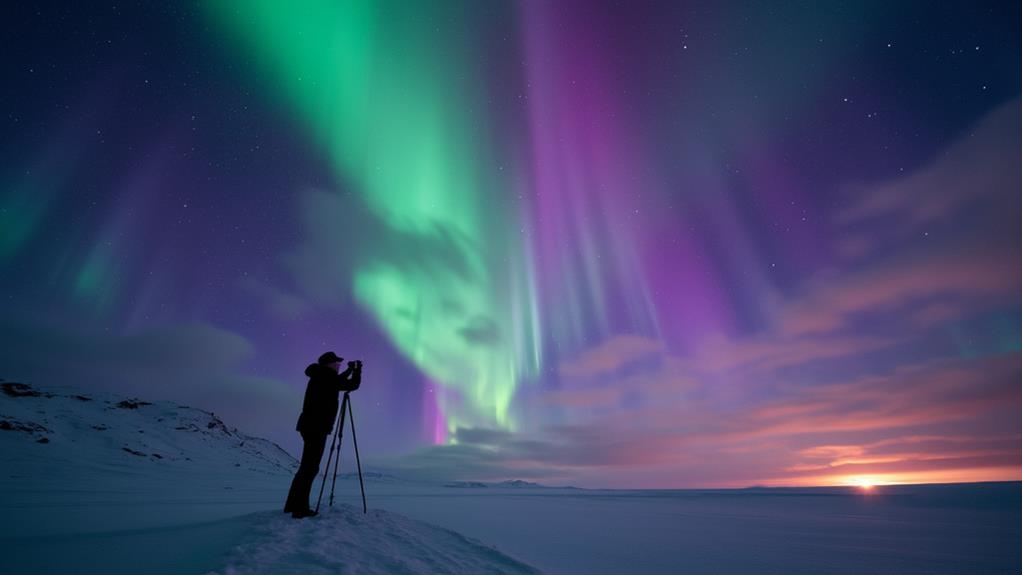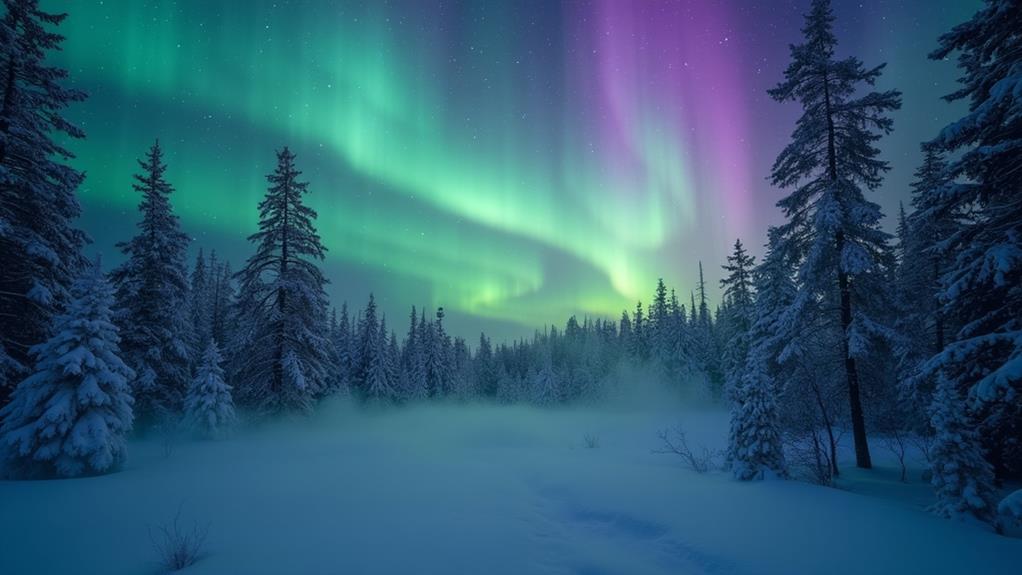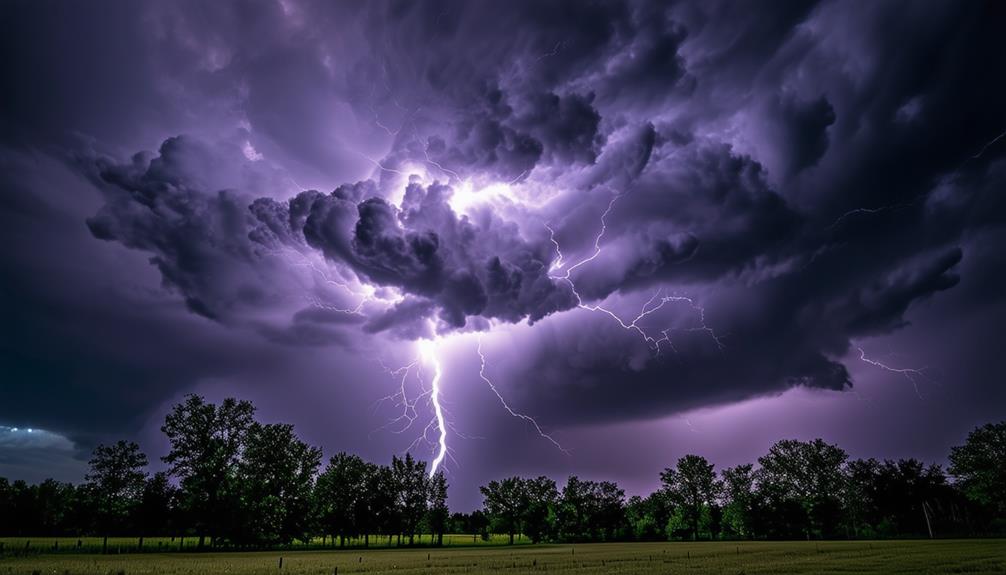The Connection Between Solar Activity and the Northern Lights
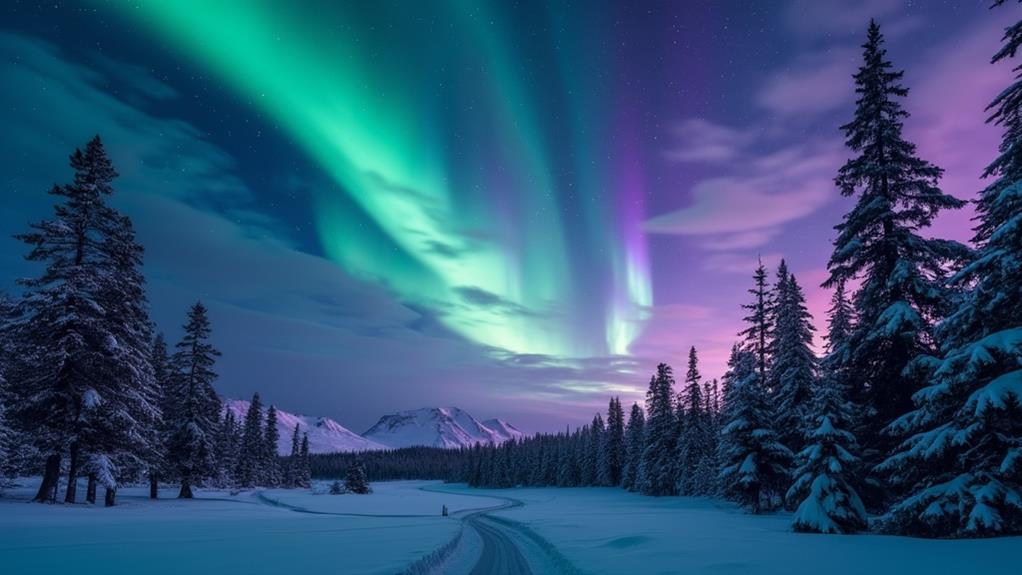
The mesmerizing Northern Lights are a direct result of solar activity, specifically the sun's cycles, which influence the intensity of these auroras. During periods of heightened solar activity, such as Solar Maximum, the sun ejects a stream of charged particles called the solar wind. When these particles collide with Earth's magnetic field, they generate the stunning light displays we see. Key events, like Coronal Mass Ejections (CMEs), can significantly amplify these interactions, leading to particularly vivid auroras. Let's delve deeper into how these processes unfold and their impact on the Northern Lights.
Understanding Solar Cycles
Solar cycles, typically averaging around 11 years but varying between 8 to 14 years, are crucial for understanding fluctuations in solar energy output and sunspot activity. These cycles significantly impact Earth, particularly during the Solar Maximum, the peak of sunspot activity, which enhances auroral displays.
Sunspots, solar flares, and coronal mass ejections (CMEs) are key indicators of solar activity. During the Solar Maximum, increased sunspot activity leads to a rise in the frequency and intensity of these phenomena, resulting in more vibrant and frequent auroral displays, also known as the northern lights.
Solar Cycle 25, which began in December 2019, is expected to peak around July 2025. This period offers heightened auroral visibility. Additionally, magnetic field reversals occur approximately every 11 years during solar cycles, influencing solar activity and triggering geomagnetic storms that further intensify auroras. Understanding these cycles allows for better anticipation and appreciation of the spectacular auroras visible during periods of high solar activity.
The Role of Solar Wind
The role of solar wind is pivotal in creating the stunning Northern Lights. Solar wind comprises charged particles, primarily electrons and protons, emitted from the sun's corona. When these particles collide with atoms in Earth's atmosphere, they produce the beautiful auroras. The speed and density of the solar wind directly influence the frequency and intensity of these lights.
During periods of heightened solar activity, such as the Solar Maximum, the solar wind intensifies, leading to more frequent and vibrant auroras. This increased activity often results in geomagnetic storms, which further enhance auroral displays, making them visible at lower latitudes.
| Factor | Impact on Auroras |
|---|---|
| Solar Wind Speed | Increases aurora intensity |
| Charged Particle Density | Boosts aurora frequency |
| Geomagnetic Storms | Extends aurora visibility |
In the auroral zone (66°N to 69°N), where Earth's magnetic field is weaker, solar wind particles penetrate more deeply into the atmosphere, making auroras a common sight. During significant solar events, these lights can be seen even further south, offering a spectacular show to a broader audience. Understanding the role of solar wind helps appreciate the dynamic nature of these celestial displays.
Coronal Mass Ejections
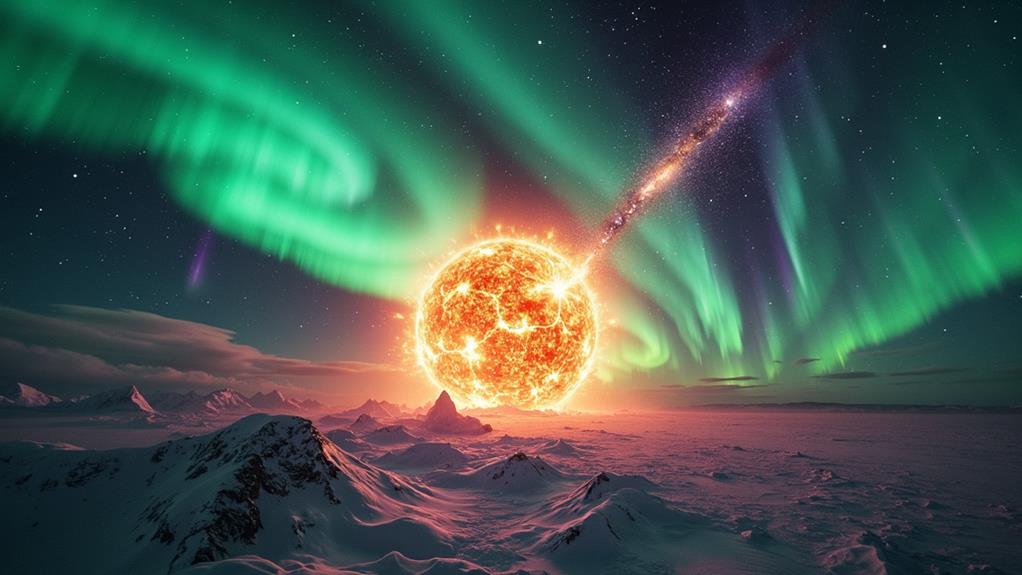
Coronal Mass Ejections (CMEs) are pivotal in creating the awe-inspiring Northern Lights. These massive bursts of plasma and magnetic fields from the sun can reach Earth in as little as 17 hours. When a CME collides with Earth, it can trigger geomagnetic storms, leading to spectacular auroras visible at lower latitudes than usual, particularly during periods of heightened solar activity.
CMEs often accompany solar flares, serving as early indicators of potential geomagnetic disturbances. The energetic particles from these ejections interact with Earth's magnetosphere, exciting atoms in the ionosphere. This interaction produces the mesmerizing displays of the Northern Lights. Historical records demonstrate that significant solar storms caused by CMEs have led to auroras appearing in unexpected regions, underscoring their profound impact.
Key points about CMEs:
- Travel Time: CMEs can reach Earth in as little as 17 hours.
- Geomagnetic Storms: They can incite geomagnetic storms, amplifying auroral activity.
- Early Warnings: CMEs often accompany solar flares, signaling possible disturbances.
- Auroras at Lower Latitudes: During periods of heightened solar activity, auroras can be observed farther from the poles.
Understanding CMEs enhances your appreciation of the science behind the magnificent Northern Lights.
Geomagnetic Storms Explained
Geomagnetic storms are temporary disturbances in Earth's magnetosphere caused by solar wind shock waves and coronal mass ejections (CMEs) from the sun. These storms are measured using indices like the Dst index and have distinct phases. Their effects include phenomena such as auroras and disruptions in navigation systems.
Definition and Causes
Geomagnetic storms, temporary disturbances of Earth's magnetosphere, primarily result from solar wind shock waves generated by coronal mass ejections (CMEs) and co-rotating interaction regions (CIRs). When solar winds from these events strike Earth's magnetosphere, they induce significant geomagnetic activity. This activity is closely tied to the sunspot cycle, an 11-year period marked by fluctuating solar activity levels.
Key points on how these geomagnetic storms impact our planet include:
- Solar Winds: Charged particles from the sun interact with Earth's magnetosphere.
- Coronal Mass Ejections (CMEs): Massive bursts of solar wind and magnetic fields from the sun's corona.
- Auroras: Stunning light displays in the polar regions, a direct result of geomagnetic storms.
- Sunspot Cycle: Periods of increased solar activity, leading to more frequent geomagnetic disturbances.
These storms are most frequent during solar maxima, the peak of the sunspot cycle. Historical events like the Carrington Event in 1859 caused widespread auroral displays and disrupted telegraph systems. Understanding geomagnetic storms helps us prepare for their effects on communication systems, navigation, and power grids.
This knowledge is crucial for maintaining the stability and functionality of modern technological infrastructure, ensuring minimal disruption during such geomagnetic events.
Measurement and Classification
Understanding geomagnetic storms requires accurate measurement and classification of their intensity. Geomagnetic storms, which are caused by solar storms, are quantified using the Disturbance Storm Time (Dst) index. This index measures changes in Earth's magnetosphere by tracking the horizontal magnetic field at the equator. During quiet periods, the Dst index typically ranges between +20 and -20 nanoteslas (nT). When the Dst index drops below -50 nT, a geomagnetic storm is occurring. Severe storms can drive this value down to between -250 nT and -600 nT.
To interpret these values, the G-scale classification system is used. This system ranges from G1 (minor) to G5 (extreme), providing a straightforward way to understand storm intensity. For example, a G1 storm may cause minor auroral activity, while a G5 storm can bring auroras to much lower latitudes than usual due to the significant influx of solar wind particles.
Phases and Effects
Understanding the intensity of geomagnetic storms through measurement and classification sets the stage for examining their phases and effects. A geomagnetic storm typically unfolds in three distinct phases: initial, main, and recovery.
In the initial phase, there's a rapid increase in the Dst index, ranging from 20 to 50 nT, indicating the arrival of charged particles from solar events. Although brief, this phase paves the way for the main phase.
During the main phase, the Dst index drops significantly, often below -50 nT. This phase, lasting from 2 to 8 hours, is when the geomagnetic storm is most intense, with Dst values sometimes plummeting between -250 nT and -600 nT. Such intense activity can push auroras into lower latitudes, making them visible far from the usual auroral zones.
Finally, the recovery phase can span from 8 hours to 7 days. During this phase, the Dst index gradually returns to between +20 and -20 nT, signaling a return to quieter conditions.
Key effects of geomagnetic storms include:
- Solar energetic particle events
- Disruptions in navigation systems
- Increased auroral activity at lower latitudes
- Potential damage to power grids and communication systems
These phases and effects showcase how solar activity directly impacts both technology and natural phenomena like auroras.
Auroras and Solar Activity
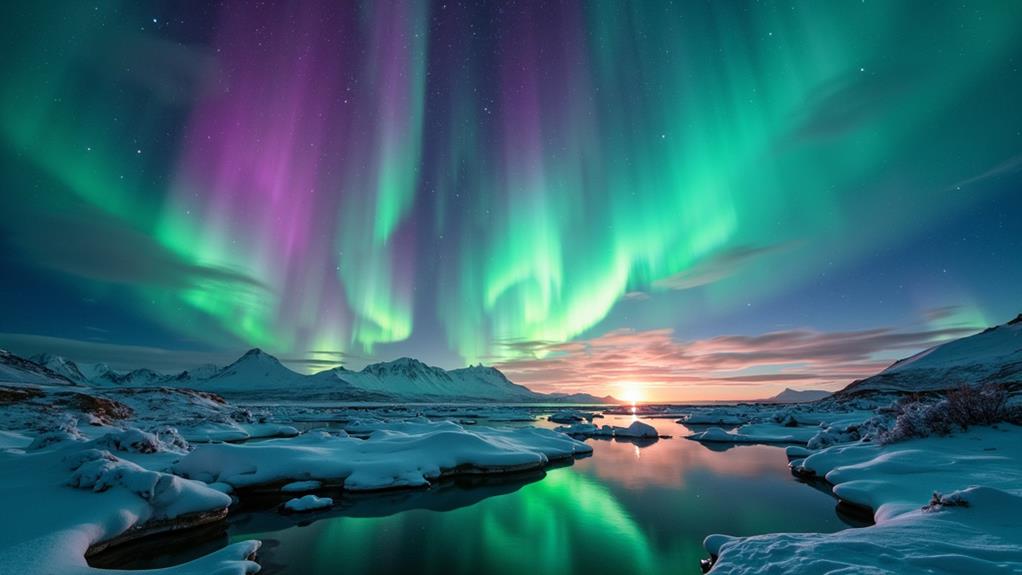
Solar flares and sunspot activity significantly impact the Northern Lights. When the Sun releases flares or experiences heightened sunspot activity, it sends charged particles toward Earth, resulting in more frequent and vivid auroral displays. Understanding these solar events allows for better predictions of when and where to witness these stunning light shows.
Solar Flares' Impact
When solar flares erupt from the sun, they don't just release energy into space; they amplify the drama of Earth's auroras. These intense bursts of radiation significantly enhance auroral activity by energizing solar particles that reach our planet. As these energetic solar wind particles interact with Earth's magnetosphere, they excite atmospheric atoms, resulting in vibrant auroras.
During periods of heightened solar activity, particularly around solar maximum, auroras become more frequent and intense. This is because solar flares often precede coronal mass ejections (CMEs), which can lead to more widespread and spectacular auroral displays. These combined solar events can even make auroras visible at lower latitudes than usual.
Here's a concise breakdown of how solar flares impact auroras:
- Solar flares energize particles, increasing auroral activity.
- Interaction with Earth's magnetosphere produces colorful auroras.
- CMEs following solar flares intensify and spread auroral displays.
- Heightened auroral activity is common around solar maximum.
Monitoring solar flares and their effects is crucial for predicting aurora occurrences. These flares often correlate with geomagnetic storms, enhancing auroral visibility and creating breathtaking natural light shows.
Sunspot Activity Correlation
Sunspot activity, a key indicator of solar cycles, often heralds increased auroral displays. An uptick in sunspots signals the approach of the solar maximum, the peak of the approximately 11-year solar cycle. During this phase, auroras become more frequent and intense.
Sunspots are regions of intense magnetic activity on the sun, often leading to solar flares and coronal mass ejections (CMEs). These CMEs release charged particles that, upon reaching Earth's atmosphere, interact with gases to produce auroras.
Historical records show that during solar maximum, solar storms can generate auroras visible far from polar regions, even at lower latitudes. Monitoring sunspot counts can help predict spikes in auroral activity. As we near the peak of the current solar cycle around 2025, increased sunspot activity will likely signal more spectacular auroras.
Predicting Auroral Displays
Predicting auroral displays depends on understanding and monitoring solar activity. By observing solar flares and coronal mass ejections (CMEs), you can anticipate when charged particles might reach Earth and ignite stunning auroras. The Space Weather Prediction Center (SWPC) provides reliable alerts and forecasts crucial for this purpose.
To predict auroras effectively, you should:
- Track solar activity, especially during the Solar Maximum, expected to peak around 2024-2025.
- Monitor the Dst index, noting that significant auroral displays often occur when Dst values drop below -50 nT during geomagnetic storms.
- Focus on the Aurora Zone, where auroras are most frequently observed, particularly from September to March.
- Check SWPC updates to plan ideal viewing times, usually between 5 p.m. and 2 a.m.
Solar flares and CMEs are key indicators. When these solar phenomena occur, they send charged particles toward Earth, potentially leading to geomagnetic storms that intensify auroras. By leveraging resources like the SWPC, you can enhance your chances of witnessing these breathtaking natural displays. Understanding the interplay between solar activity and auroras ensures you are well-prepared to experience the magic of the Northern Lights.
Historical Solar Events
The history of solar activity includes several significant events that have profoundly impacted human technology and natural phenomena. One of the most notable is the Carrington Event of September 1859, the largest recorded solar storm. It caused widespread communication disruptions, particularly in telegraph systems, and led to auroras visible as far south as Mexico and Hawaii. This event highlighted the intense geomagnetic activity that can accompany such solar phenomena.
In November 1882, another major solar storm disrupted telecommunications and produced auroras in places like Mendocino, California. Similarly, the May 1921 New York Railroad Storm caused fires and infrastructure damage, with auroras illuminating the skies over San Francisco.
In August 1972, a series of solar flares led to communication disruptions and even accidental naval mine detonations due to increased geomagnetic activity, emphasizing the potential hazards of solar storms.
The March 1989 geomagnetic storm resulted in a major power outage affecting six million people in Quebec and produced auroras visible across various regions. These events underscore the powerful connection between solar activity and the mesmerizing northern lights.
Effects on Technology
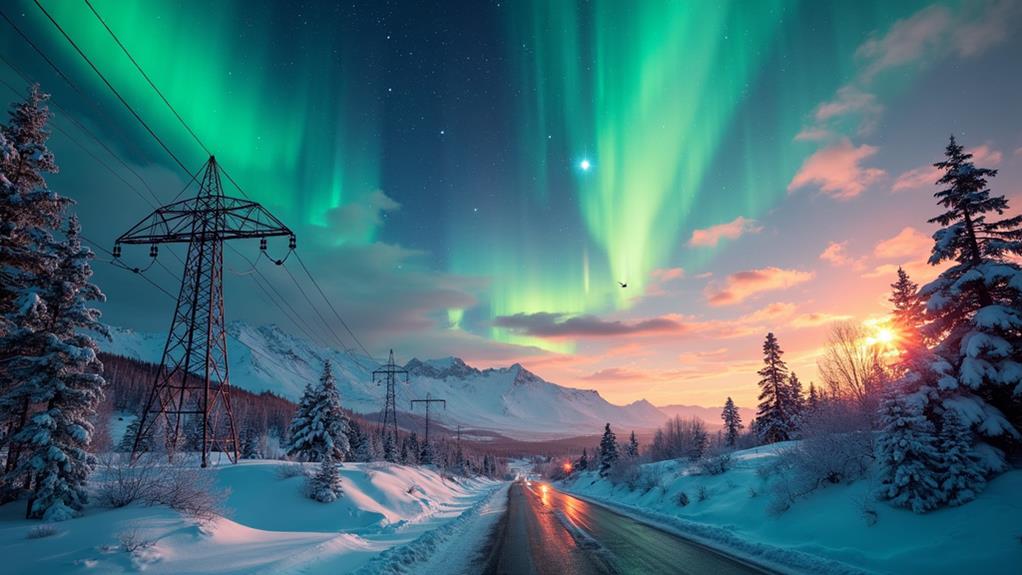
Experiencing a geomagnetic storm can significantly disrupt modern technology, leading to widespread impacts. Solar storms, which often produce stunning Northern Lights, can induce powerful geomagnetically induced currents (GICs) in power grids. These currents have the potential to cause major failures and outages, as evidenced by the March 1989 storm that blacked out Quebec, affecting six million people.
Satellite communications are also at risk during solar storms. Disruptions can affect:
- GPS accuracy
- Communication systems
- Financial transactions
- High-altitude flights
These disturbances are not merely inconvenient; they pose serious risks. Increased radiation levels during solar events threaten astronauts and can necessitate the rerouting of high-altitude flights for safety.
The economic damages from a severe solar storm, akin to the historic Carrington Event, could range from $1 to $2 trillion. Such extensive disruptions highlight the need for improved infrastructure resilience. Mitigation strategies, including better forecasting, are crucial to minimize these impacts.
Understanding the connection between solar activity and the Northern Lights underscores the importance of preparing for technological disruptions caused by geomagnetic storms, ensuring that critical systems remain operational.
Monitoring Solar Activity
Monitoring Solar Activity
Understanding the profound effects of solar storms on technology naturally leads us to the methods used to monitor solar activity. A key player in this effort is the Solar Dynamics Observatory (SDO). The SDO provides real-time imagery and critical data on sunspot counts, solar flares, and coronal mass ejections (CMEs), all of which significantly influence auroral activity.
Magnetometers measure variations in the Earth's magnetic field, particularly around auroral zones and equatorial regions, helping scientists track geomagnetic storms. These storms can dramatically impact auroral displays, creating a visual spectacle in the night sky.
Coherent and incoherent scatter radar systems probe the ionosphere to provide insights into electron density profiles, which directly correlate with solar activity. Particle detectors, such as Geiger counters and scintillator detectors, analyze the charge and mass composition of solar particles, further enhancing our understanding of their impact on Earth's atmosphere.
Planning Northern Lights Trips
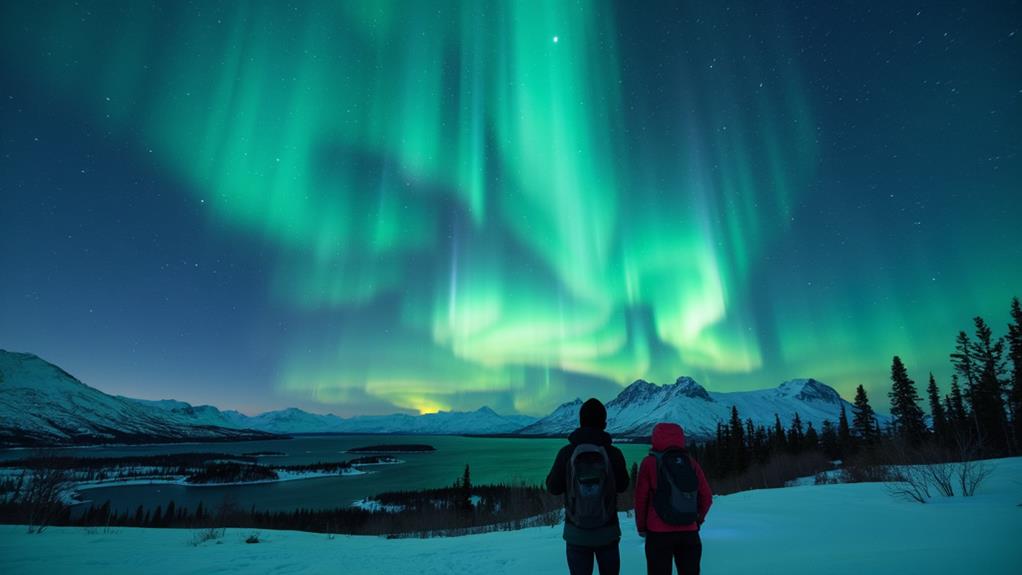
Planning a trip to see the Northern Lights can be an exciting adventure, especially if you know where and when to go. The Northern Lights appear most vividly within the Auroral Zone, making places like Fairbanks, Alaska, prime destinations due to their consistent auroral activity. To optimize your chances of witnessing this natural wonder, consider these tips:
- Optimal viewing months: Plan your trip between September and March, with peak activity occurring between 5 p.m. and 2 a.m.
- Weather conditions: Choose destinations with clear skies, as cloud cover can hinder visibility. Hurtigruten voyages can help you navigate to clearer areas.
- Planning tours: Schedule your trip around new moons to minimize light interference and enhance the aurora's visibility.
- High-latitude regions: Opt for locations like Norway, Canada, and Alaska, which offer the best opportunities for sightings. Occasionally, the lights are visible in lower U.S. states like Minnesota, Michigan, and Ohio.
Research and Future Trends
Planning a Northern Lights trip is an exhilarating experience, and understanding the science behind these awe-inspiring displays can enhance your journey. Current research aims to refine predictive models for solar activity and its effects on auroras. Utilizing data from satellites such as the Solar Dynamics Observatory (SDO) and NOAA's monitoring systems, scientists strive to forecast the timing and location of auroras with greater precision.
We are currently in Solar Cycle 25, which is expected to peak around 2025, potentially leading to more frequent and intense auroral displays. This cycle's increased solar activity, particularly coronal mass ejections (CMEs), is known to amplify auroral phenomena. Understanding these solar dynamics is crucial for predicting Northern Lights visibility.
Ongoing studies are also investigating the relationship between solar activity and climate variations. By examining how changes in solar output affect both auroras and broader climate patterns, scientists aim to gain deeper insights into Earth's complex systems.
International collaboration in space weather research is essential for advancing our understanding. By pooling resources and expertise, researchers can enhance aurora forecasting and monitoring systems, thereby increasing your chances of experiencing these breathtaking natural displays.

